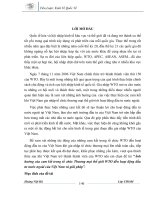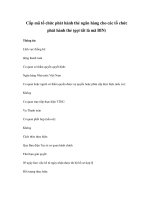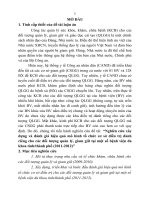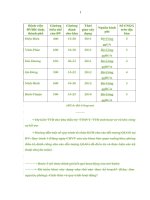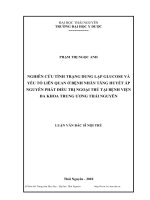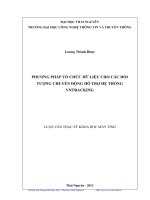- Trang chủ >>
- Y - Dược >>
- Ngoại khoa
Pocket guide to kidney stone prevention
Bạn đang xem bản rút gọn của tài liệu. Xem và tải ngay bản đầy đủ của tài liệu tại đây (2.06 MB, 167 trang )
Manoj Monga
Kristina L. Penniston
David S. Goldfarb Editors
Pocket Guide to Kidney
Stone Prevention
Dietary and
Medical Therapy
123
Pocket Guide to Kidney
Stone Prevention
wwwwwwwwwwww
Manoj Monga
Kristina L. Penniston
David S. Goldfarb
Editors
Pocket Guide to Kidney
Stone Prevention
Dietary and Medical Therapy
Editors
Manoj Monga, MD, FACS
Stevan Streem Center for
Endourology & Stone Disease
The Cleveland Clinic
Cleveland, OH, USA
Kristina L. Penniston, PhD, RD
Department of Urology
University of Wisconsin School
of Medicine and Public
Health
Madison, WI, USA
David S. Goldfarb, MD, FACP,
FASN
Nephrology Division
NYU Langone Medical Center
New York, NY, USA
ISBN 978-3-319-11097-4
ISBN 978-3-319-11098-1 (eBook)
DOI 10.1007/978-3-319-11098-1
Springer Cham Heidelberg New York Dordrecht London
Library of Congress Control Number: 2014952903
© Springer International Publishing Switzerland 2015
This work is subject to copyright. All rights are reserved by the Publisher,
whether the whole or part of the material is concerned, specifically the rights of
translation, reprinting, reuse of illustrations, recitation, broadcasting, reproduction on
microfilms or in any other physical way, and transmission or information storage
and retrieval, electronic adaptation, computer software, or by similar or dissimilar
methodology now known or hereafter developed. Exempted from this legal
reservation are brief excerpts in connection with reviews or scholarly analysis or
material supplied specifically for the purpose of being entered and executed on
a computer system, for exclusive use by the purchaser of the work. Duplication
of this publication or parts thereof is permitted only under the provisions of the
Copyright Law of the Publisher’s location, in its current version, and permission
for use must always be obtained from Springer. Permissions for use may be
obtained through RightsLink at the Copyright Clearance Center. Violations are
liable to prosecution under the respective Copyright Law.
The use of general descriptive names, registered names, trademarks, service
marks, etc. in this publication does not imply, even in the absence of a specific
statement, that such names are exempt from the relevant protective laws and
regulations and therefore free for general use.
While the advice and information in this book are believed to be true and accurate
at the date of publication, neither the authors nor the editors nor the publisher
can accept any legal responsibility for any errors or omissions that may be made.
The publisher makes no warranty, express or implied, with respect to the material
contained herein.
Printed on acid-free paper
Springer is part of Springer Science+Business Media (www.springer.com)
To our patients
wwwwwwwwwwww
Preface
Kidney stones place a heavy burden on physicians and society
but most importantly they significantly impact our patients’
quality of life. Those who have a first stone attack are highly
motivated to make changes to try to avoid recurrence, yet
unfortunately only the minority receive appropriate evaluation and counseling.
This handbook was designed to provide the evidencebased tools to make patient-centered recommendations that
can decrease the risk of stone recurrence and improve quality
of life. We hope you and your patients find it helpful.
Cleveland, OH, USA
Madison, WI, USA
New York, NY, USA
Manoj Monga
Kristina L. Penniston
David S. Goldfarb
vii
wwwwwwwwwwww
Contents
Part I
Counseling the First Time Stone Former
1 What Is the Risk of Stone Recurrence? .....................
Juan C. Calle
3
2 General Nutrition Guidelines
for All Stone Formers ...................................................
Margaret Wertheim
9
3 24-Hour Urine and Serum Tests:
When and What? ...........................................................
R. Allan Jhagroo
19
Part II Calcium Stones
Section 1 Hypercalciuria
4 Nutrition Management of Hypercalciuria ..................
E. Susannah Southern
29
5 Medical Management of Hypercalciuria ....................
Sushant R. Taksande and Anna L. Zisman
37
Section 2
Hypocitraturia
6 Nutrition Management of Hypocitraturia ..................
Liz Weinandy
49
7 Medical Management of Hypocitraturia ....................
Cynthia Denu-Ciocca
55
ix
x
Contents
Section 3
Hyperoxaluria
8 Nutritional Management of Hyperoxaluria ...............
Kristina L. Penniston
Part III
63
Uric Acid Stones
9 Nutrition Management of Uric Acid Stones ..............
Lisa A. Davis
75
10 Medical Management of Uric Acid Stones ................
John S. Rodman
81
Part IV
Cystine Stones
11 Cystinuria........................................................................
Michelle A. Baum
Part V
91
Struvite Stones
12 Struvite Stones, Diet and Medications ....................... 101
Ben H. Chew, Ryan Flannigan, and Dirk Lange
Part VI
Follow-Up of the Recurrent Stone Former
13 Laboratory Follow-Up of the Recurrent
Stone Former.................................................................. 113
Sutchin R. Patel
14 Imaging (Cost, Radiation) ............................................ 123
Michael E. Lipkin
15 What to Do About Asymptomatic Calculi................. 131
Shubha De and Sri Sivalingam
Contents
Part VII
xi
Managing Recurrence
16 Acute Renal Colic and Medical
Expulsive Therapy ......................................................... 139
Charles D. Scales Jr. and Eugene G. Cone
17 Stratifying Surgical Therapy......................................... 149
Vincent G. Bird, Benjamin K. Canales,
and John M. Shields
Index...................................................................................... 161
wwwwwwwwwwww
Contributors
Michelle A. Baum, MD Division of Nephrology, Boston
Children’s Hospital/Harvard Medical School, Boston, MA,
USA
Vincent G. Bird, MD Department of Urology, University of
Florida College of Medicine, Gainesville, FL, USA
Juan C. Calle, MD Department of Nephrology and
Hypertension, Cleveland Clinic, Cleveland, OH, USA
Benjamin K. Canales, MD Department of Urology,
University of Florida College of Medicine, Gainesville, FL,
USA
Ben H. Chew, MD, MSc, FRCSC Department of Urological
Sciences, University of British Columbia, Vancouver, BC,
Canada
Eugene G. Cone, MD Division of Urologic Surgery, Duke
University Medical Center, Durham, NC, USA
Lisa A. Davis, MS, RD Clinical Research Unit, University of
Wisconsin Institute for Clinical and Translational Research,
Clinical Science Center, Madison, WI, USA
Shubha De, MD, FRCPC Cleveland Clinic, Glickman
Urological and Kidney Institute, Cleveland, OH, USA
Cynthia Denu-Ciocca, MD Kidney Center, University of
North Carolina at Chapel Hill, Chapel Hill, NC, USA
xiii
xiv
Contributors
Ryan Flannigan, MD Department of Urologic Sciences,
University of British Columbia, Vancouver, BC, Canada
R. Allan Jhagroo, MD Department of Medicine and Urology,
University of Wisconsin Madison, Madison, WI, USA
Dirk Lange, MD Department of Urologic Sciences,
University of British Columbia, Vancouver, BC, Canada
Michael E. Lipkin, MD Division of Urology, Surgery, Duke
University Medical Center, Durham, NC, USA
Sutchin R. Patel, MD Department of Urology, University of
Wisconsin, School of Medicine and Public Health, Gurnee,
IL, USA
Kristina L. Penniston, PhD, RD Department of Urology,
University of Wisconsin, School of Medicine and Public
Health, Madison, WI, USA
John S. Rodman, MD Department of Medicine/Nephrology,
Weill Cornell School of Medicines, New York, NY, USA
Charles D. Scales Jr., MD, MSHS Division of Urologic
Surgery, Duke University Medical Center, Durham, NC, USA
John M. Shields, MD Department of Urology, University of
Florida College of Medicine, Gainesville, FL, USA
Sri Sivalingam, MD, MSC, FRCSC Cleveland Clinic,
Glickman Urological and Kidney Institute, Cleveland,
OH, USA
E. Susannah Southern, RDN, LDN Department of Nutrition
& Food Services, UNC Health Care, UNC Outpatient
Nutrition Clinic, Aycock Family Medicine, Chapel Hill, NC,
USA
Sushant R. Taksande, MD Department of Medicine/Section
of Nephrology, Pritzker School of Medicine, University of
Chicago, Chicago, IL, USA
Contributors
xv
Liz Weinandy, MPH, RD, LD Nutrition Services, Ohio State
University Wexner Medical Center, Dublin, OH, USA
Margaret Wertheim, MS, RD Department of Urology,
University of Wisconsin Madison, Madison, WI, USA
Anna L. Zisman, MD Department of Medicine/Section of
Nephrology, Pritzker School of Medicine, University of
Chicago, Chicago, IL, USA
Part I
Counseling the First Time
Stone Former
Chapter 1
What Is the Risk of Stone
Recurrence?
Juan C. Calle
On average, it is estimated that 1 in 11 Americans will suffer
at least one episode of nephrolithiasis in their life time
according to the most recent report from a cross-sectional
analysis of large epidemiologic data from the National
Health and Nutrition Examination Survey (NHANES) 2007–
2010. These data clearly show an increase in the incidence
and prevalence of the disease when compared to previous
reports from the same database from the period between
1976 and 1980. Multiple factors including changes in diet and
lifestyle, increasing epidemics of obesity and diabetes, migration from rural cooler settings to warmer urban areas, and
even possibly changes in the global environment with warmer
temperatures may all be contributing to this increase in
kidney stones [1].
The risk of recurrence after a first kidney stone remains
controversial. As early as 1919, Dr. Lamson in a speech
before the Association of Residents and Ex-Residents of the
Mayo Clinic mentioned a very wide rate of recurrence ranging from 10 to 48 % [2]. Nowadays, reported frequencies of
kidney stone recurrence after a first episode range from 30 to
50 % at 5 years in uncontrolled studies and as much as 100 %
J.C. Calle, MD (*)
Department of Nephrology and Hypertension, Cleveland Clinic,
9500 Euclid Avenue, Cleveland, OH 44195, USA
e-mail:
M. Monga et al. (eds.), Pocket Guide to Kidney
Stone Prevention, DOI 10.1007/978-3-319-11098-1_1,
© Springer International Publishing Switzerland 2015
3
4
J.C. Calle
recurrence in patients who form single stones if they were
followed for longer than 25 years [3]. These data indicate the
complex and heterogeneous natural history of nephrolithiasis. However, recent data from control groups in randomized,
controlled trials suggest much lower rates, ranging from 2 to
5 % per year. The risk of recurrence increases with each new
stone formed [4]. Therefore, the importance of prevention
and assessment of the risk of stone recurrence is highly relevant to any patient and health care provider involved in their
care, in particular for those patients with more complex and
severe disease.
Some risk factors for stone recurrence cannot be modified;
examples include gender, age, family history, gastrointestinal
diseases that impact fluid balance and electrolytes, genetic
conditions or urologic issues such as medullary sponge kidney
or horseshoe kidneys. Other endocrine diseases, mainly related
to management of calcium and phosphorus, such as primary
hyperparathyroidism, may be modified and treatable [5].
Other independent factors that may increase the chances
of recurrence as high as 10 % per year include a history of
multiple relapses, increased levels of alkaline phosphatase,
stones located in lower calyces as compared to the renal pelvis, multiple stones, stone size larger than 20 mm and younger
age. The type of surgical treatment for the first stone event
may also influence the recurrence rate and is an active field
for research, although many confounding variables make
retrospective observations inconclusive [6].
Although metabolic work-up and its possible effect to lower
the risk of stone recurrence has not been thoroughly demonstrated, some individuals may benefit from counseling and
management based on these results. Metabolic evaluation
should then be offered specifically to patients with multiple
stones or first stones among complicated cases, in single kidneys,
transplant recipients, patients with known severe associated
co-morbid conditions, and interested first-time formers [7].
Perhaps the most important aspect of the metabolic workup is the volume collected during the 24 h collection. Lower
urinary volumes have been recognized as a prominent risk
1.
What Is the Risk of Stone Recurrence?
5
factor for recurrence of kidney stones as demonstrated by a
well-conducted study by Borghi et al. [8]. Hypercalciuria is
the most common abnormality found in patients with kidney
stones and urine metabolic work-up other than low fluid
intake and low urinary output [9].
Calcium oxalate stones remain as the most common type
of kidney stone. Though 24-h urine collections are often used
to direct preventive strategies, the values of individual variables at which the risk of recurrence increases are poorly
defined. For hyperoxaluria, even small increased levels, generally considered normal (e.g., 25 mg/day) have been shown
to put patients at higher risk for formation of stones [10].
Similarly, though hyperuricosuria promotes calcium oxalate
stone formation, and medical therapy directed at decreasing
urinary uric acid decrease stone recurrence [11], the actual
amount of urinary uric acid that increases risk and the role of
uric acid in the formation of calcium oxalate stones remains
to be elucidated [10].
Urinary citrate plays a role as an endogenous inhibitor of
kidney stones by formation of a nondissociable but soluble
complex with calcium, hence, decreasing the availability of the
calcium to bind with oxalate or phosphate and form crystals.
Hypocitraturia, which may happen as an isolated event or in
association with other abnormalities also plays an important
role as a risk factor for recurrence of kidney stones [12].
As mentioned previously in this chapter, each of these risk
factors or components may individually increase the risk of
stone recurrence; however, it seems they may all be interconnected, reflected by calculations of supersaturation that have
been shown to directly correlate with the formation of kidney
stones and subsequent recurrence of the disease. This predictive ability was shown in a large retrospective study by Parks
et al. in which patients followed for up to two decades in a
specialized kidney stone clinic had less recurrence of stones.
This result seemed to be directly correlated with lower levels
of supersaturation, at least for those forming calcium oxalate
stones [13]. Even though this result has not been confirmed
yet in large, randomized control studies, the goal of treatment
6
J.C. Calle
and management of stone prevention should be targeted
towards normalization or improvement of supersaturation as
it is recommended in the most recent American Urological
Association Guidelines for the medical management of
kidney stones [14].
Due to the high recurrence of the disease, multiple
co-morbid associations, its impact on quality of life, and the
costs directly and indirectly associated with it, kidney stones
should be considered a chronic illness that requires long-term
advice and management by qualified health care providers
with expertise and experience in the subject. Research
regarding prevention to decrease the number of relapses is
largely and desperately needed.
References
1. Scales Jr CD, Smith AC, Hanley JM, Saigal CS. Urologic diseases
in America project. Prevalence of kidney stones in the United
States. Eur Urol. 2012;62(1):160–5.
2. Lamson OF. Recurrent nephrolithiasis. Ann Surg.
1920;71(1):16–21.
3. Coe FL, Keck J, Norton ER. The natural history of calcium urolithiasis. JAMA. 1977;238(14):1519–23.
4. Borghi L, Schianchi T, Meschi T, Guerra A, Allegri F, Maggiore U,
et al. Comparison of two diets for the prevention of recurrent
stones in idiopathic hypercalciuria. N Engl J Med. 2002;346:77–84.
5. Worcester EM, Coe FL. Clinical practice. Calcium kidney stones.
N Engl J Med. 2010;363(10):954–63.
6. Chongruksut W, Lojanapiwat B, Tawichasri C, Paichitvichean S,
Euathrongchit J, Ayudhya VC, et al. Predictors for kidney stones
recurrence following extracorporeal shock wave lithotripsy
(ESWL) or percutaneous nephrolithotomy (PCNL). J Med
Assoc Thai. 2012;95(3):342–8.
7. Calle JC, Monga M. Metabolic evaluation: underuse or overdone?
In: Practical controversies in medical management of stone disease. New York: Springer Science+Business Media; 2014. p. 1–6.
8. Borghi L, Meschi T, Amato F, Briganti A, Novarini A, Giannini
A. Urinary volume, water and recurrences in idiopathic calcium
nephrolithiasis: a 5-year randomized prospective study. J Urol.
1996;155(3):839–43.
1.
What Is the Risk of Stone Recurrence?
7
9. Curhan GC, Willett WC, Speizer FE, Stampfer MJ. Twenty-fourhour urine chemistries and the risk of kidney stones among
women and men. Kidney Int. 2001;59(6):2290–8.
10. Curhan GC, Taylor EN. 24-h uric acid excretion and the risk of
kidney stones. Kidney Int. 2008;73(4):489.
11. Ettinger B, Tang A, Citron JT, Livermore B, Williams
T. Randomized trial of allopurinol in the prevention of calcium
oxalate calculi. N Engl J Med. 1986;315(22):1386.
12. Parks JH, Coe FL. A urinary calcium-citrate index for the evaluation of nephrolithiasis. Kidney Int. 1986;30(1):85.
13. Parks JH, Coe FL. Evidence for durable kidney stone prevention over several decades. BJU Int. 2009;103(9):1238–46.
14. Pearle MS, Goldfarb DS, Assimos DG, Curhan G, Denu-Ciocca
CJ, Matlaga BR, et al. Medical management of kidney stones:
AUA guideline. J Urol. 2014;192(2):316–24.
Chapter 2
General Nutrition Guidelines
for All Stone Formers
Margaret Wertheim
There are multiple nutritional influences on kidney stone risk,
regardless of stone type. These factors include energy balance
as it relates to body composition, fluid intake, sodium intake,
purine intake from animal flesh, and the acid load of the diet.
A 24-h urine collection is used to identify metabolic and environmental risk factors. An assessment of the patient’s habitual
diet and dietary pattern is used to identify which of these risk
factors has a nutritional contributor. When results from the
urine analysis are used in combination with a thorough nutrition assessment by a registered dietitian (RD), a comprehensive and individualized nutrition care plan can be developed
to address the dietary contributors to stone risk factors.
While it is recommended to tailor nutrition therapy to
each patient based on his/her demonstrated risk factors,
much as is done in pharmacologic therapy where the medication addresses a measured aberration, there are a few guidelines that all stone formers may follow, regardless of the
type of stones they form and of their individual risk factors.
This chapter provides the rationale for and strategies to
implement these recommendations.
M. Wertheim, MS, RD (*)
Department of Urology, University of Wisconsin Madison,
3253 Medical Foundation Centennial Building, 1685 Highland Avenue,
Madison, WI 53705, USA
e-mail:
M. Monga et al. (eds.), Pocket Guide to Kidney
Stone Prevention, DOI 10.1007/978-3-319-11098-1_2,
© Springer International Publishing Switzerland 2015
9
10
M. Wertheim
Energy
Obesity is associated with higher risk for kidney stones
through multiple mechanisms. Obese patients tend to have
higher urinary excretion of oxalate and uric acid [1], and
lower urinary citrate [2]. Obesity is also associated with
increased sodium and phosphorus excretion, and urinary pH
is inversely associated with body weight. Insulin resistance,
frequently seen in obese patients, has also been associated
with defects in renal ammonia production, while hyperinsulinemia is reported to increase urinary calcium excretion [1].
Because obesity plays an important role in metabolic
stone disease, assessment of a patient’s BMI and consideration of the effect of weight on stone risk factors is a part of
the nutrition assessment. BMI is calculated either through
the use of BMI charts or using the following equation:
BMI = (weight in kg)/(height in m2). A patient with a BMI of
25.0 or greater is overweight, while a patient with a BMI of
30.0 or higher is classified as obese.
Overweight and obese patients should be counseled that
weight loss is an important goal for reducing stone risk factors.
It is helpful to provide patients with an estimate of their daily
calorie needs to promote either energy balance or weight loss.
There are multiple equations used to predict energy expenditure. While the Harris–Benedict equation is still used in clinical
practice, recent data suggest that the most accurate equations
for calculating resting metabolic rate (RMR) are the Mifflin St.
Jeor and Livingston equations. These equations are seen
below with W = weight (kg), H = height (cm), A = age (years)
[3]. RMR is then multiplied by one of the activity factors below
(Table 2.1) to determine total energy expenditure.
• Mifflin St. Jeor
Women: RMR = 10W + 6.25H − 5A − 161
Men: RMR = 10W + 6.25H − 5A + 5
• Livingston
Women: RMR = 248 × W^0.43356 − 5.09A
Men: RMR = 293 × W^0.4330 − 5.92A
2.
General Nutrition Guidelines for All Stone Formers
11
TABLE 2.1. Activity factors for calculating total energy expenditure.
Activity level
Very light activity
Light activity
Moderate activity
Heavy activity
Activity factor
1.3
1.5
1.6
1.9
Fluids
Stone formers may have lower 24-h urine volumes than
healthy controls, and increasing fluid intake in patients with a
history of stones will decrease stone risk. Increasing fluid
intake decreases the concentration of calcium, oxalate, phosphorus, and uric acid in the urine and decreases relative
supersaturation of calcium oxalate, brushite, and uric acid [4].
Fluid needs vary between individuals. The daily fluid
intake goal needs to be individualized based on a target urine
output of at least 2.5 L daily. Extra-renal losses from perspiration, respiration, and stool vary considerably between individuals based on comorbidities, perspiration, occupation,
climate, and activity level [5]. Provider considerations in
developing individualized daily fluid intake goals include:
1. Patients with chronic loose stools or diarrhea will have
increased extra-renal losses that need to be compensated
for with increased fluid intake.
2. Patients with occupations or activities that require time
outside in the heat with increased sweat losses will require
increased fluid intake to compensate.
3. Urinary incontinence, frequent nocturia, occupations with
lack of access to restroom for extended periods of time
(such as truck drivers, airline pilots, and elementary school
teachers) may need a personalized fluid schedule.
Patient strategies in complying with daily fluid intake
goals include:
1. Divide the day into 2–3 sections and consume a target
volume of fluids in each section. For example, instruct
the patient to consume 1 L fluids in each of three 5-hour
